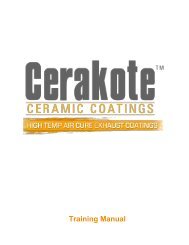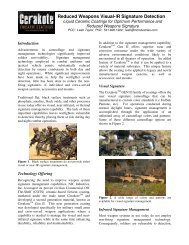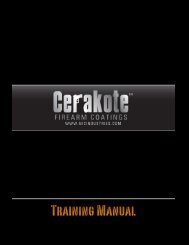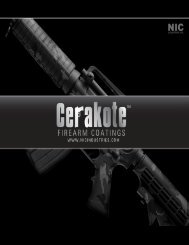Cerakote TM High Temp Air Cure Exhaust Coatings - Northwest ...
Cerakote TM High Temp Air Cure Exhaust Coatings - Northwest ...
Cerakote TM High Temp Air Cure Exhaust Coatings - Northwest ...
Create successful ePaper yourself
Turn your PDF publications into a flip-book with our unique Google optimized e-Paper software.
!"#$%$%&'(#%)#*''<br />
' Thermal Barrier Testing<br />
Four different <strong>Cerakote</strong> <strong>TM</strong> products were tested to determine the potential of each as<br />
a thermal‐barrier coating. These four coatings are shown in table 2 with their<br />
respective properties. Each of these coatings were used to coat a 3’ long section of<br />
pipe. The pipes were manufactured of cold‐rolled steel and had an inner diameter of<br />
2”. The pipes were cured according to the appropriate cure schedule and then<br />
horizontally mounted using 2 clamps spaced 6” from the center of each pipe. Three<br />
thermocouples, one in the center, one 3” from the inlet and one 3” from the outlet,<br />
were positioned on each pipe. Each thermocouple was held in place using a band<br />
clamp. A gas burner was attached to the inlet side of each pipe and the pipes were<br />
heated according to the following program:<br />
Start condition: Ambient air at 100 SCFM<br />
Ramp to 572°F in 1 minute, hold for 10 minutes<br />
Ramp to 1112°F in 1 minute, hold for 10 minutes<br />
Ramp to 1706°F in 1 minute, hold for 10 minutes, and the air flow rate was<br />
maintained at 100 SCFM for the duration of the test. The inlet gas temperature and<br />
the temperatures recorded by the 3 skin thermocouples were also monitored and<br />
recorded at 1 second intervals. The results of this test are illustrated in figure 1 and<br />
further explained in table 3. At temperatures below 572°F, C‐7300 Black Velvet<br />
performed the best. Above 572°F V‐171 Turbine Coat provided the most thermal<br />
protection. At 572°F, using C‐7300 Black Velvet as a thermal barrier resulted in a<br />
110°F drop in outer skin temperature. At 1112°F and 1706°F, V‐171 Turbine Coat<br />
resulted in a 102°F and 185°F drop, respectively. Afterward, the pipes were examined<br />
in order to assess any deterioration in the physical or visual properties. C‐186, C‐7300,<br />
and V‐171 maintained adhesion of 5B as well as color and gloss. W‐207/W‐350<br />
showed a slight loss in adhesion and gloss. This can potentially be prevented by<br />
coating the inside of the pipe<br />
with V‐171 turbine coat.<br />
Table 2. Physical properties of four different <strong>Cerakote</strong><strong>TM</strong> coatings tested for thermal barrier properties.<br />
Type of <strong>Cerakote</strong><strong>TM</strong><br />
Adhesion<br />
AS<strong>TM</strong> D3359<br />
Scratch<br />
Hardness/Hardness<br />
AS<strong>TM</strong> D3363<br />
Impact<br />
AS<strong>TM</strong> 2794<br />
Mandrel Bend<br />
AS<strong>TM</strong> D522<br />
C‐186 Piston Coat 5B 5h/9h 40/20 inch‐lbs 4 mm at 180° rotation<br />
C‐7300 Black Velvet 5B 6h/7h 40/20 inch‐lbs 2 mm at 180° rotation<br />
W-207/W-350<br />
Chromex/ Base Coat<br />
5B<br />
2b/9h<br />
100/40 inch-lbs 0 mm at 180° rotation<br />
V-171 Turbine Coat 4B 4h/5h 60/20 inch-lbs 1 mm at 180° rotation<br />
17






